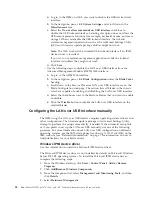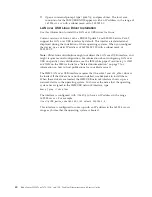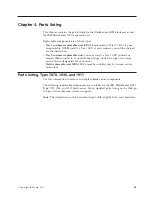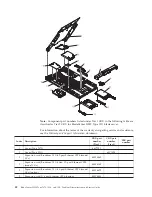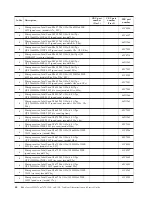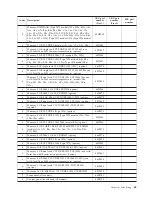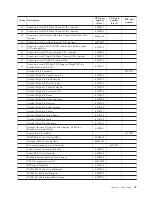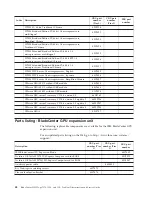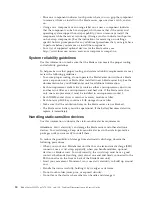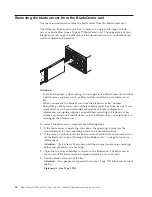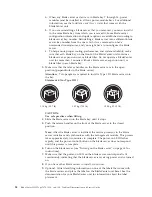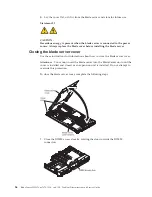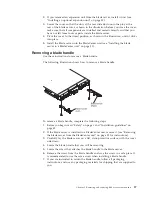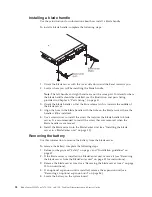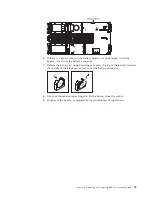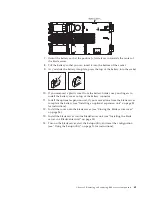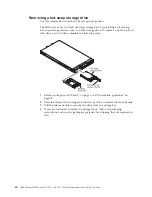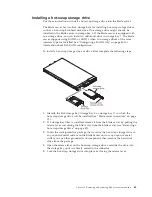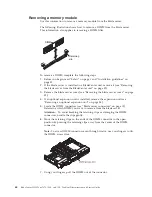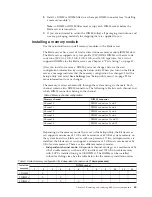
v
Blue on a component indicates touch points, where you can grip the component
to remove it from or install it in the blade server, open or close a latch, and so
on.
v
Orange on a component or an orange label on or near a component indicates
that the component can be hot-swapped, which means that if the server and
operating system support hot-swap capability, you can remove or install the
component while the server is running. (Orange can also indicate touch points
on hot-swap components.) See the instructions for removing or installing a
specific hot-swap component for any additional procedures that you might have
to perform before you remove or install the component.
v
For a list of supported optional devices for the blade server, see
http://www.ibm.com/servers/eserver/serverproven/compat/us/.
System reliability guidelines
Use this information to make sure that the blade server meets the proper cooling
and reliability guidelines.
To help make sure that proper cooling and system reliability requirements are met,
review the following guidelines:
v
To ensure proper cooling, do not operate the BladeCenter unit without a blade
server, expansion unit, or blade filler installed in each blade-server bay. See the
documentation for your BladeCenter unit for additional information.
v
Each microprocessor socket always contains either a microprocessor dust cover
and heat sink filler or a microprocessor and heat sink. If the blade server has
only one microprocessor, it must be installed in microprocessor socket 1.
v
Each DIMM socket always contains a memory module or filler.
v
Each hot-swap SAS bay contains a SAS storage drive or filler.
v
Make sure that the ventilation holes on the blade server are not blocked.
v
The blade server battery must be operational. If the battery becomes defective,
replace it immediately.
Handling static-sensitive devices
Use this information to observe the static-sensitive device requirements.
Attention:
Static electricity can damage the blade server and other electronic
devices. To avoid damage, keep static-sensitive devices in their static-protective
packages until you are ready to install them.
To reduce the possibility of damage from electrostatic discharge, observe the
following precautions:
v
When you work on a BladeCenter unit that has an electrostatic discharge (ESD)
connector, use a wrist strap, especially when you handle modules, optional
devices, or blade servers. To work correctly, the wrist strap must have a good
contact at both ends (touching your skin at one end and firmly connected to the
ESD connector on the front or back of the BladeCenter unit).
v
Limit your movement. Movement can cause static electricity to build up around
you.
v
Handle the device carefully, holding it by its edges or its frame.
v
Do not touch solder joints, pins, or exposed circuitry.
v
Do not leave the device where others can handle and damage it.
50
BladeCenter HS22 Type 7870, 1936, and 1911: Problem Determination and Service Guide
Summary of Contents for 7870B4U
Page 1: ...BladeCenter HS22 Type 7870 1936 and 1911 Problem Determination and Service Guide...
Page 2: ......
Page 3: ...BladeCenter HS22 Type 7870 1936 and 1911 Problem Determination and Service Guide...
Page 14: ...xii BladeCenter HS22 Type 7870 1936 and 1911 Problem Determination and Service Guide...
Page 20: ...6 BladeCenter HS22 Type 7870 1936 and 1911 Problem Determination and Service Guide...
Page 34: ...20 BladeCenter HS22 Type 7870 1936 and 1911 Problem Determination and Service Guide...
Page 248: ...234 BladeCenter HS22 Type 7870 1936 and 1911 Problem Determination and Service Guide...
Page 252: ...238 BladeCenter HS22 Type 7870 1936 and 1911 Problem Determination and Service Guide...
Page 260: ...246 BladeCenter HS22 Type 7870 1936 and 1911 Problem Determination and Service Guide...
Page 266: ...252 BladeCenter HS22 Type 7870 1936 and 1911 Problem Determination and Service Guide...
Page 267: ......
Page 268: ...Part Number 90Y5614 Printed in USA 1P P N 90Y5614...



